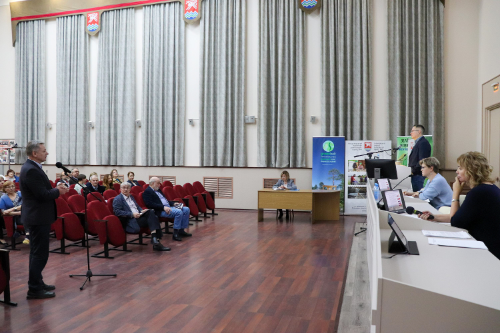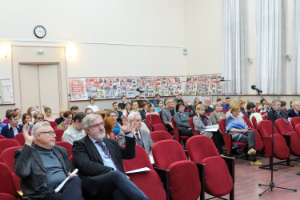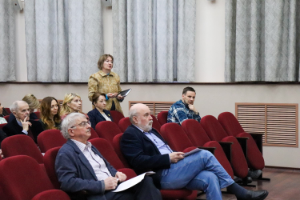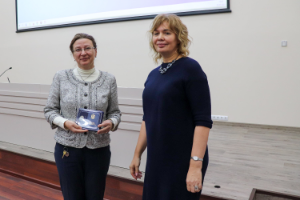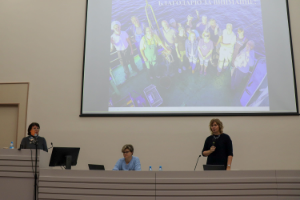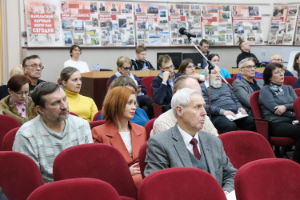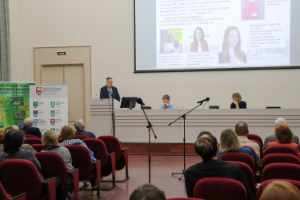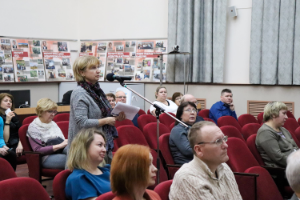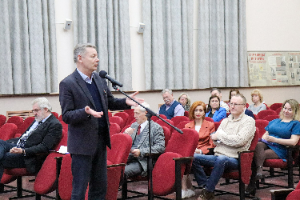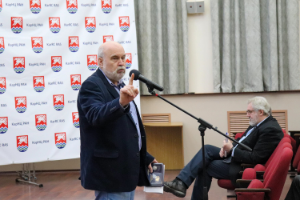Institute of Biology KarRC RAS in 2022 performed research in the general and physicochemical biology fields within 59 research themes. Studies were carried out within 8 state-ordered themes and 24 projects. As a result, 217 scientific papers were published, including a monograph. In 2022, Senior Researcher at IB KarRC RAS Nina Nemova was elected a RAS Full Academician.
As Director of the Institute of Biology KarRC RAS Viktor Ilyukha informed the gathering, staff of the Ecological Biochemistry Laboratory demonstrated how the lipid profile can be used to reliably evaluate the physiological status of mesopelagic (living at 200-900 m depths) fish.
These findings help understand the mechanisms for compensatory biochemical response selection and implementation in deep-water organisms, their role in matter and energy cycling between surface and deep layers of the sea water column.
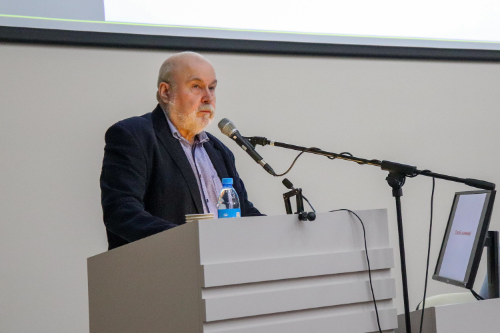
Director of the Institute of Biology KarRC RAS Viktor Ilyukha
Another important area of activity for scientists at the institute is the study of invasive species.
– Many of our laboratories do research on biological invasions of alien species. Long-term studies of their biology and ecology, their invasion of high latitudes have enabled tracking the main trends and causes of the expansion. This refers to mammals as well, – Viktor Ilyukha remarked.
In particular, scientists certify: the golden jackal reaches ever farther north. Encounters of the animal have already been reported from European Russia – Moscow, Leningrad, and Arkhangelsk Regions. Potential pathways for the golden jackal’s expansion to the Arctic have been identified.
Biologists have also assayed tissues of wild boars for concentrations of vital and toxic elements in kidneys, liver, and flesh of animals from western parts of Karelia. They found that wild boars suffered a deficit of a majority of vital elements. Scientists also urged to be cautious about eating the meat of game animals.
Commenting on the report, KarRC RAS Director General Olga Bakhmet pointed out the substantial increase in the number of scientific articles authored by the institute’s staff published in reputable international journals. “This is a major achievement. The number of such high-standard articles is an accurate indicator of performance”, – the organization’s leader remarked.
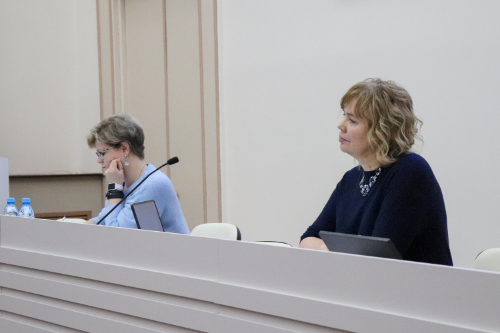
KarRC RAS Director General, RAS Corr. Academician Olga Bakhmet and KarRC RAS Secretory for Science Natalya Fokina
Forest Research Institute KarRC RAS did research within 3 state-ordered themes listed in the Russian Federal Basic Research Program, 3 projects funded by RFBR, 4 projects funded by RSF, and under 19 research contracts with Russian partners. Staff of the Institute have participated in the activities of the Russian Arctic Research and Education Center and in creating the national carbon monitoring system. The studies have resulted in the publication of 63 articles and the textbook “Clonal micropropagation of rare members of the genus Betula L.”. The Institute interacts and collaborates with RAS, the Federation Council, and other federal and regional forest policy decision-making bodies.
Talking about the main forest-related studies, Director of the Forest Research Institute Alexander Kryshen informed that scientists have detected the traits of the signaling pathway that controls the division and differentiation of cambial (constituting the generative tissue in woody plants) cells.
– This result is important for understanding the effect of this signaling module on plant productivity. It can be used when working out the methods of growing timber with desired properties. This is the future of sylviculture and we’re working in this direction, – Director emphasized.
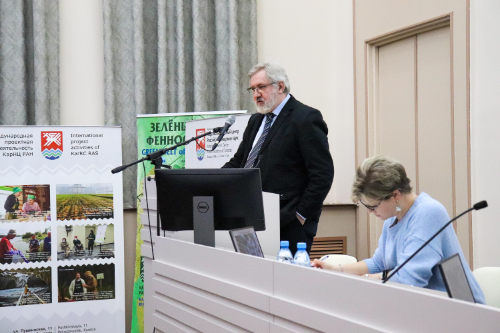
Director of the Forest Research Institute KarRC RAS Alexander Kryshen speaking
The Institute is doing topical research on carbon balance in forest ecosystems. In particular, scientists have explored the rates of pith wood formation processes depending on the age of the cambium (trunk generative tissue). Based on the results, the estimates of carbon content in trunk wood can be refined by 5-7 percent. Scientists have also estimated the contribution of heterotrophic respiration to total carbon dioxide emissions from the surface of forest soils in cowberry-type pine forests. They found that up to 77% of the soil CO2 flux is effected by microbial respiration.
Discussing the report, members of the KarRC RAS Learned Council especially noted the outreach activities of the Institute’s staff and their work with young professionals.
– Another impressive fact is the number of doctoral students the Institute is training and the overall approach to working with the youth. I’d also like to acknowledge the work of the Forest Research Institute’s Young Scientists Council, which performs quite a number of functions, – Olga Bakhmet said.
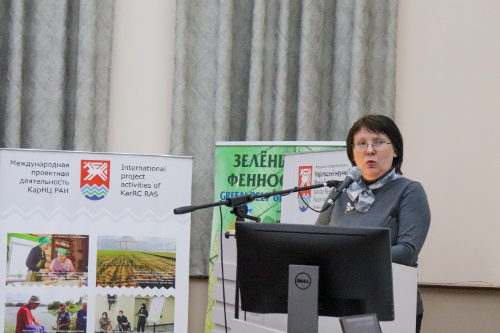
Director of the Northern Water Problems Institute KarRC RAS Larissa Nazarova
Northern Water Problems Institute KarRC RAS last year carried out research within 5 themes under state assignment, within 4 RSF projects, 1 RFBR project, and under 3 commercial research contracts. The outputs of the latter were handed over to the customers to be implemented for sustainable development of the republic, environment conservation, and public ecological safety. A total of 79 scientific papers were published. The monograph “Paleolimnology of Lake Onego: from an ice lake to the modern environment” was prepared.
Director of the Northern Water Problems Institute Larissa Nazarova named the state-ordered themes the unit is working on and the related results. To wit, the Institute implements integrated studies of the White Sea and its catchment to create the basis for the development of the Russian Arctic zone.
– Last year, the main feature of the ongoing changes of the hydrological conditions in rivers of the White Sea catchment was identified. This is a substantial increase in the water content during the winter season simultaneously with a rise in mean monthly air temperatures. It is statistically significant, – Larissa Nazarova remarked.
Besides, a negative trend in the ice consolidation ratio is observed for the entire White Sea water area.
– One component of this work was assessment of the potential effects of the region’s economy and the related wastewater discharges and atmospheric emissions on the condition of the sea. The situation in the region in the past five years has been quite stable, as opposed to Russia on average, – Director summed up.
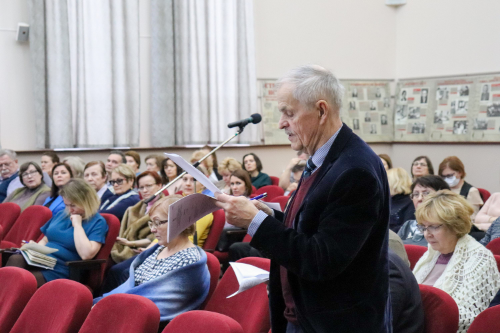
Chief Researcher at NWPI KarRC RAS, RAS Corr. Academician Nikolai Filatov
Studies of the current condition and forecasting of the development of small lake ecosystems in Karelia have shown that the present climate changes in Southern Karelia - warm winters, frequent thaws - reduce the thickness and alter the structure of ice on lakes. The proportion of so-called white ice, which is not as strong and transparent as crystalline ice, is growing. This necessitates a revision of ice safety rules. Also, studies within this theme revealed the set of hydro-thermodynamic conditions that trigger mass propagation of cyanobacteria in small lakes: no-wind conditions and water warming to more than 20 degrees Celsius, given the required level of nutrients.
Special attention when discussing the report was given to the Institute’s vigorous fieldwork. It is implemented on almost all the research themes. Expeditions are organized using the research vessels Ekolog and Poseidon.
Institute of Geology KarRC RAS performed research within seven state-ordered themes and within Russian and international projects. A total of 139 articles were published in Russian journals and abroad. Two monographs came out, a version of the guidebook to the geological heritage of Karelia adapted for children “Educative Travels of Karelian Animals: Science for the Youngest Ones” was published. The original guidebook was recognized as the Book of the Year in Karelia in the Light of Science category.
Specialists from the Institute of Geology KarRC RAS last year carried out both basic research and studies of applied value for the region’s economy.
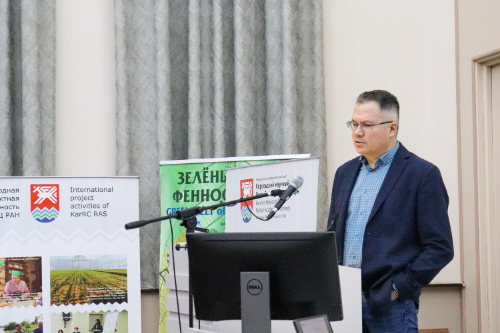
Director of the Institute of Geology KarRC RAS Sergey Svetov
According to the Director of the Institute Sergey Svetov, Karelian scientists are actively involved in the study of the global-scope topic of atmosphere formation on the planet, including the aspect of the origin and evolution of life on Earth. Analysis of samples taken from the Onega Stratigraphic Well continues. Last year, studies of the isotopic composition of chromium in sedimentary rocks were completed. They were carried out by an international team which included employees of the Institute of Geology KarRC RAS. It has been confirmed that 2.1-2.0 billion years ago the oxygen content was sufficient for the appearance of eukaryotes, the first organisms with nuclei in their cells. However, the first widely recognized fossil evidence of the existence of complex eukaryotic cells is dated to 1.7 Ga. Scientists now know that this delay was not due to the limited amount of oxygen in the atmosphere. It can be attributed to other limiting environmental factors or to the longer evolution of the first organisms.
As part of the study of the region's mineral reserves, specialists investigated the content of indium in Pitkyaranta deposit minerals. Indium is a metal used in the manufacturing of liquid-crystal displays, microelectronics and in other spheres.
– This study has demonstrated the potential of certain complexes in the Ladoga region, where indicator minerals have been detected and indium reserves have been estimated. We are not talking about mining right now, but this is our potential future," noted Sergey Svetov.
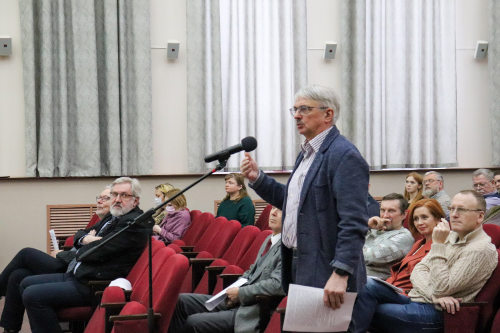
KarRC RAS Deputy Director General, Doctor of Geology and Mineralogy Alexander Slabunov
The part of the meeting dedicated to the work of the Institute of Geology KarRC RAS was concluded by a series of questions and remarks within the discussion. As a summary, the Center's Director General Olga Bakhmet emphasized the importance of the scientists' outreach and educational activities. The institute operates the Young Geologists Club Archean, young scientists implement the GeoKarelia project in schools, and events are organized for citizens. "The forms of scientific knowledge popularization in which schoolchildren, students, and the general public get actively involved are extremely important and effective", - Olga Bakhmet summed up.
More presentations by directors of institutes are coming during the second part of the KarRC RAS Learned Council session on January 25th.




